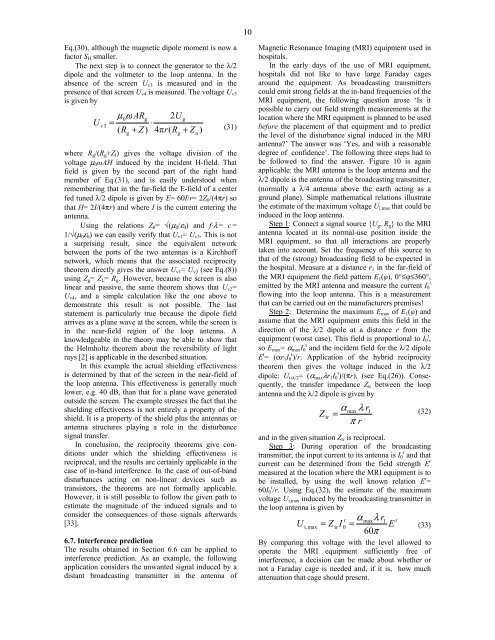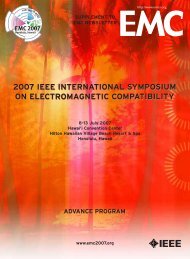reciprocity and emc measurements - IEEE Electromagnetic ...
reciprocity and emc measurements - IEEE Electromagnetic ...
reciprocity and emc measurements - IEEE Electromagnetic ...
You also want an ePaper? Increase the reach of your titles
YUMPU automatically turns print PDFs into web optimized ePapers that Google loves.
10Eq.(30), although the magnetic dipole moment is now afactor S H smaller.The next step is to connect the generator to the λ/2dipole <strong>and</strong> the voltmeter to the loop antenna. In theabsence of the screen U v3 is measured <strong>and</strong> in thepresence of that screen U v4 is measured. The voltage U v3is given byUv3µ0ωARg2Ug= ⋅( Rg+ Z)4πr(Rg+ Za)(31)where R g /(R g +Z l ) gives the voltage division of thevoltage µ 0 ωAH induced by the incident H-field. Thatfield is given by the second part of the right h<strong>and</strong>member of Eq.(31), <strong>and</strong> is easily understood whenremembering that in the far-field the E-field of a centerfed tuned λ/2 dipole is given by E= 60I/r= 2Z 0 /(4πr) sothat H= 2I/(4πr) <strong>and</strong> where I is the current entering theantenna.Using the relations Z 0 = √(µ 0 /ε 0 ) <strong>and</strong> f⋅λ = c =1/√(µ 0 ε 0 ) we can easily verify that U v1 = U v3 . This is nota surprising result, since the equivalent networkbetween the ports of the two antennas is a Kirchhoffnetwork, which means that the associated <strong>reciprocity</strong>theorem directly gives the answer U v1 = U v3 (see Eq.(8))using Z g = Z L = R g . However, because the screen is alsolinear <strong>and</strong> passive, the same theorem shows that U v2 =U v4 , <strong>and</strong> a simple calculation like the one above todemonstrate this result is not possible. The laststatement is particularly true because the dipole fieldarrives as a plane wave at the screen, while the screen isin the near-field region of the loop antenna. Aknowledgeable in the theory may be able to show thatthe Helmholtz theorem about the reversibility of lightrays [2] is applicable in the described situation.In this example the actual shielding effectivenessis determined by that of the screen in the near-field ofthe loop antenna. This effectiveness is generally muchlower, e.g. 40 dB, than that for a plane wave generatedoutside the screen. The example stresses the fact that theshielding effectiveness is not entirely a property of theshield. It is a property of the shield plus the antennas orantenna structures playing a role in the disturbancesignal transfer.In conclusion, the <strong>reciprocity</strong> theorems give conditionsunder which the shielding effectiveness isreciprocal, <strong>and</strong> the results are certainly applicable in thecase of in-b<strong>and</strong> interference. In the case of out-of-b<strong>and</strong>disturbances acting on non-linear devices such astransistors, the theorems are not formally applicable.However, it is still possible to follow the given path toestimate the magnitude of the induced signals <strong>and</strong> toconsider the consequences of those signals afterwards[33].6.7. Interference predictionThe results obtained in Section 6.6 can be applied tointerference prediction. As an example, the followingapplication considers the unwanted signal induced by adistant broadcasting transmitter in the antenna ofMagnetic Resonance Imaging (MRI) equipment used inhospitals.In the early days of the use of MRI equipment,hospitals did not like to have large Faraday cagesaround the equipment. As broadcasting transmitterscould emit strong fields at the in-b<strong>and</strong> frequencies of theMRI equipment, the following question arose ‘Is itpossible to carry out field strength <strong>measurements</strong> at thelocation where the MRI equipment is planned to be usedbefore the placement of that equipment <strong>and</strong> to predictthe level of the disturbance signal induced in the MRIantenna?’ The answer was ‘Yes, <strong>and</strong> with a reasonabledegree of confidence’. The following three steps had tobe followed to find the answer. Figure 10 is againapplicable: the MRI antenna is the loop antenna <strong>and</strong> theλ/2 dipole is the antenna of the broadcasting transmitter,(normally a λ/4 antenna above the earth acting as aground plane). Simple mathematical relations illustratethe estimate of the maximum voltage U i,max that could beinduced in the loop antenna.Step 1: Connect a signal source {U g , R g } to the MRIantenna located at its normal-use position inside theMRI equipment, so that all interactions are properlytaken into account. Set the frequency of this source tothat of the (strong) broadcasting field to be expected inthe hospital. Measure at a distance r 1 in the far-field ofthe MRI equipment the field pattern E 1 (φ), 0°≤φ≤360°,emitted by the MRI antenna <strong>and</strong> measure the current I 0tflowing into the loop antenna. This is a measurementthat can be carried out on the manufacturers premises!Step 2: Determine the maximum E max of E 1 (φ) <strong>and</strong>assume that the MRI equipment emits this field in thedirection of the λ/2 dipole at a distance r from theequipment (worst case). This field is proportional to I 0 t ,so E max = α max I 0 t <strong>and</strong> the incident field for the λ/2 dipoleE t = (αr 1 I 0 t )/r. Application of the hybrid <strong>reciprocity</strong>theorem then gives the voltage induced in the λ/2dipole: U i , λ/2 = (α max λr 1 I 0 t )/(πr), (see Eq.(26)). Consequently,the transfer impedance Z tr between the loopantenna <strong>and</strong> the λ/2 dipole is given byZαmax 1tr=λ rπ r(32)<strong>and</strong> in the given situation Z tr is reciprocal.Step 3: During operation of the broadcastingtransmitter, the input current to its antenna is I 0 r <strong>and</strong> thatcurrent can be determined from the field strength E rmeasured at the location where the MRI equipment is tobe installed, by using the well known relation E r =60I 0 r /r. Using Eq.(32), the estimate of the maximumvoltage U i,max induced by the broadcasting transmitter inthe loop antenna is given byUi,max= ZIrtr 0αmaxλr1= E60π(33)By comparing this voltage with the level allowed tooperate the MRI equipment sufficiently free ofinterference, a decision can be made about whether ornot a Faraday cage is needed <strong>and</strong>, if it is, how muchattenuation that cage should present.r
















